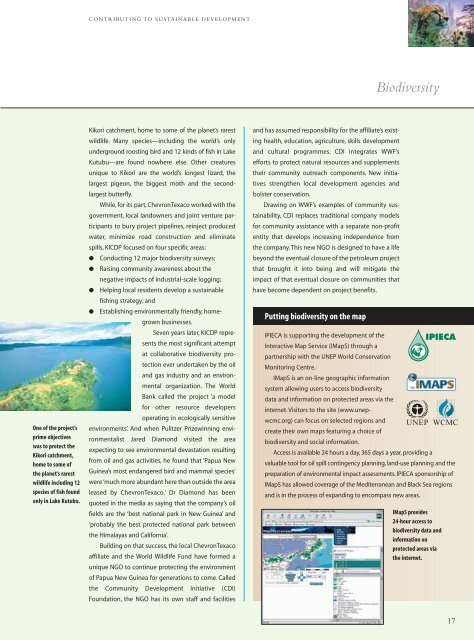WSSD Report FINAL! - OGP
WSSD Report FINAL! - OGP
WSSD Report FINAL! - OGP
You also want an ePaper? Increase the reach of your titles
YUMPU automatically turns print PDFs into web optimized ePapers that Google loves.
CONTRIBUTING TO SUSTAINABLE DEVELOPMENT<br />
Biodiversity<br />
One of the project’s<br />
prime objectives<br />
was to protect the<br />
Kikori catchment,<br />
home to some of<br />
the planet’s rarest<br />
wildlife including 12<br />
species of fish found<br />
only in Lake Kutubu.<br />
Kikori catchment, home to some of the planet’s rarest<br />
wildlife. Many species—including the world’s only<br />
underground roosting bird and 12 kinds of fish in Lake<br />
Kutubu—are found nowhere else. Other creatures<br />
unique to Kikori are the world’s longest lizard, the<br />
largest pigeon, the biggest moth and the secondlargest<br />
butterfly.<br />
While, for its part, ChevronTexaco worked with the<br />
government, local landowners and joint venture participants<br />
to bury project pipelines, reinject produced<br />
water, minimize road construction and eliminate<br />
spills, KICDP focused on four specific areas:<br />
● Conducting 12 major biodiversity surveys;<br />
● Raising community awareness about the<br />
negative impacts of industrial-scale logging;<br />
● Helping local residents develop a sustainable<br />
fishing strategy; and<br />
● Establishing environmentally friendly, homegrown<br />
businesses.<br />
Seven years later, KICDP represents<br />
the most significant attempt<br />
at collaborative biodiversity protection<br />
ever undertaken by the oil<br />
and gas industry and an environmental<br />
organization. The World<br />
Bank called the project ‘a model<br />
for other resource developers<br />
operating in ecologically sensitive<br />
environments’. And when Pulitzer Prizewinning environmentalist<br />
Jared Diamond visited the area<br />
expecting to see environmental devastation resulting<br />
from oil and gas activities, he found that ‘Papua New<br />
Guinea’s most endangered bird and mammal species’<br />
were ‘much more abundant here than outside the area<br />
leased by ChevronTexaco.’ Dr Diamond has been<br />
quoted in the media as saying that the company’s oil<br />
fields are the ‘best national park in New Guinea’ and<br />
‘probably the best protected national park between<br />
the Himalayas and California’.<br />
Building on that success, the local ChevronTexaco<br />
affiliate and the World Wildlife Fund have formed a<br />
unique NGO to continue protecting the environment<br />
of Papua New Guinea for generations to come. Called<br />
the Community Development Initiative (CDI)<br />
Foundation, the NGO has its own staff and facilities<br />
and has assumed responsibility for the affiliate’s existing<br />
health, education, agriculture, skills development<br />
and cultural programmes. CDI integrates WWF’s<br />
efforts to protect natural resources and supplements<br />
their community outreach components. New initiatives<br />
strengthen local development agencies and<br />
bolster conservation.<br />
Drawing on WWF’s examples of community sustainability,<br />
CDI replaces traditional company models<br />
for community assistance with a separate non-profit<br />
entity that develops increasing independence from<br />
the company. This new NGO is designed to have a life<br />
beyond the eventual closure of the petroleum project<br />
that brought it into being and will mitigate the<br />
impact of that eventual closure on communities that<br />
have become dependent on project benefits.<br />
Putting biodiversity on the map<br />
IPIECA is supporting the development of the IPIECA<br />
Interactive Map Service (IMapS) through a<br />
partnership with the UNEP World Conservation<br />
Monitoring Centre.<br />
IMapS is an on-line geographic information<br />
system allowing users to access biodiversity<br />
data and information on protected areas via the<br />
internet. Visitors to the site (www.unepwcmc.org)<br />
can focus on selected regions and<br />
create their own maps featuring a choice of<br />
biodiversity and social information.<br />
UNEP WCMC<br />
Access is available 24 hours a day, 365 days a year, providing a<br />
valuable tool for oil spill contingency planning, land-use planning and the<br />
preparation of environmental impact assessments. IPIECA sponsorship of<br />
IMapS has allowed coverage of the Mediterranean and Black Sea regions<br />
and is in the process of expanding to encompass new areas.<br />
IMapS provides<br />
24-hour access to<br />
biodiversity data and<br />
information on<br />
protected areas via<br />
the internet.<br />
17

















